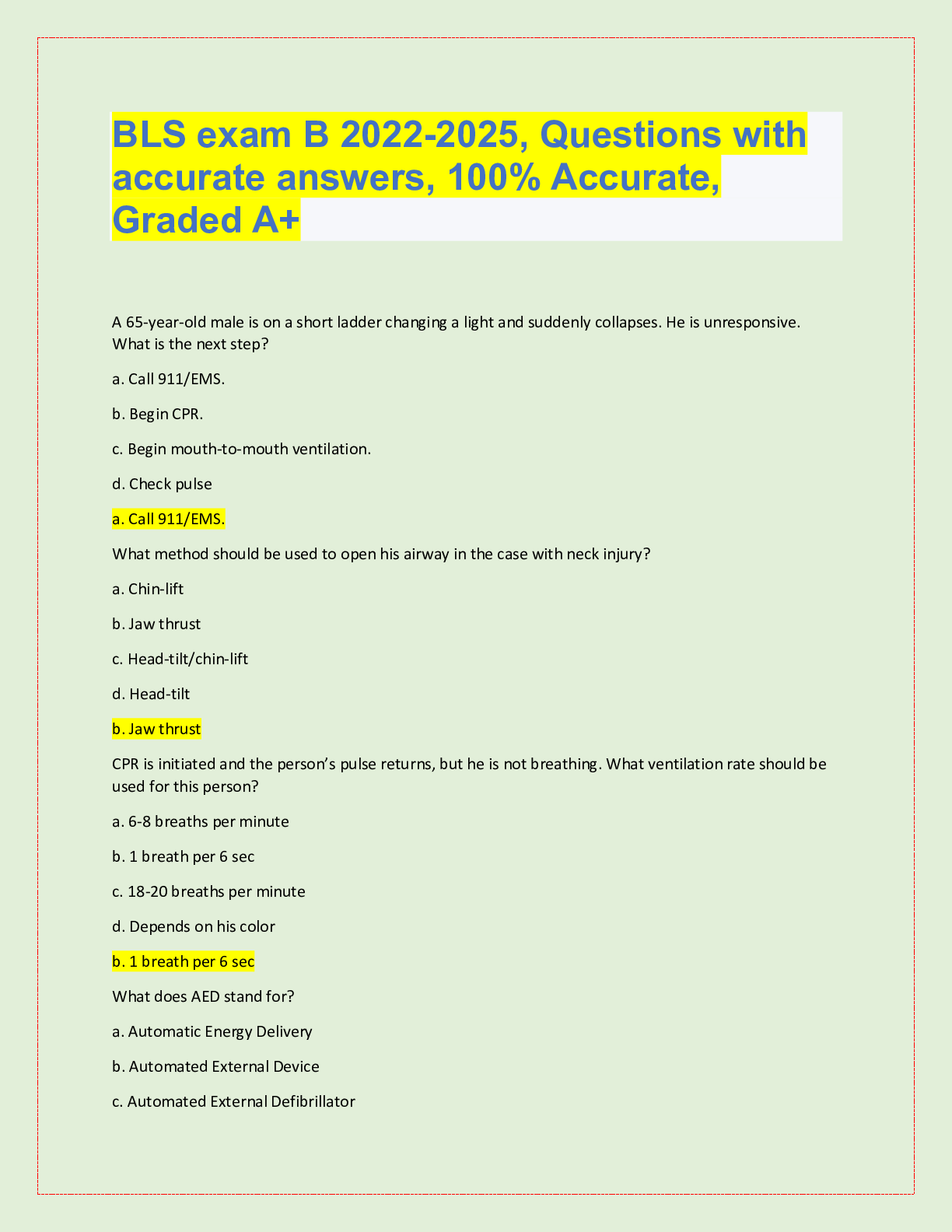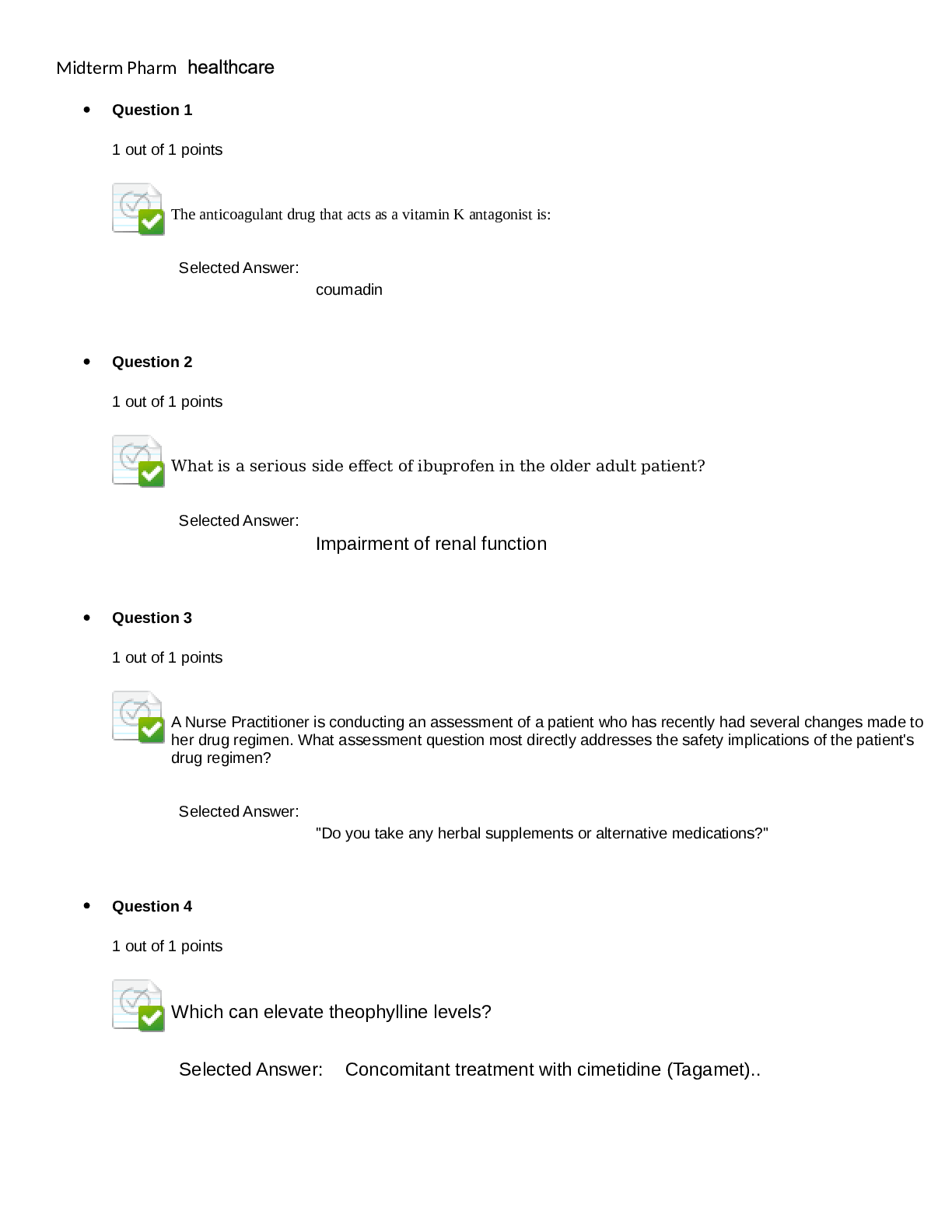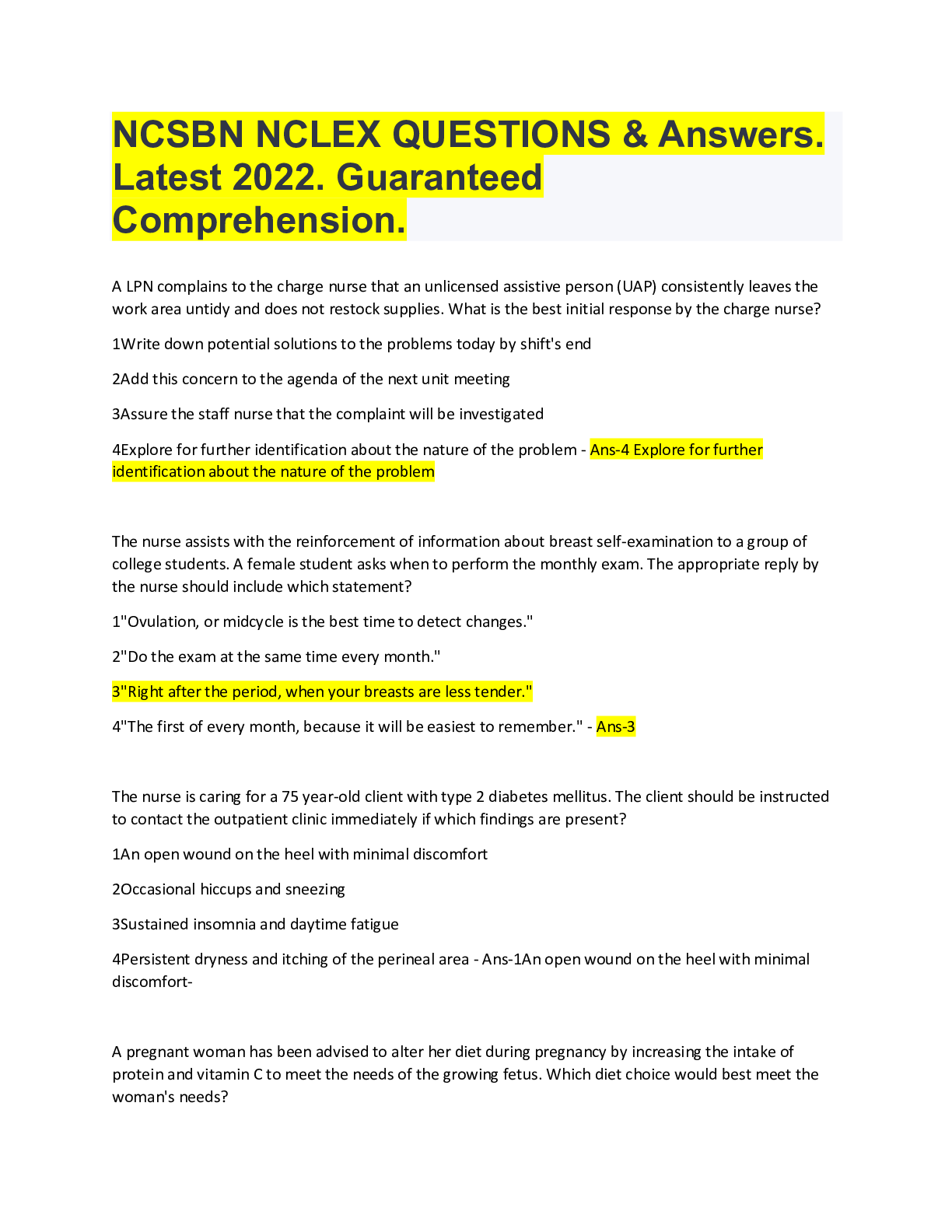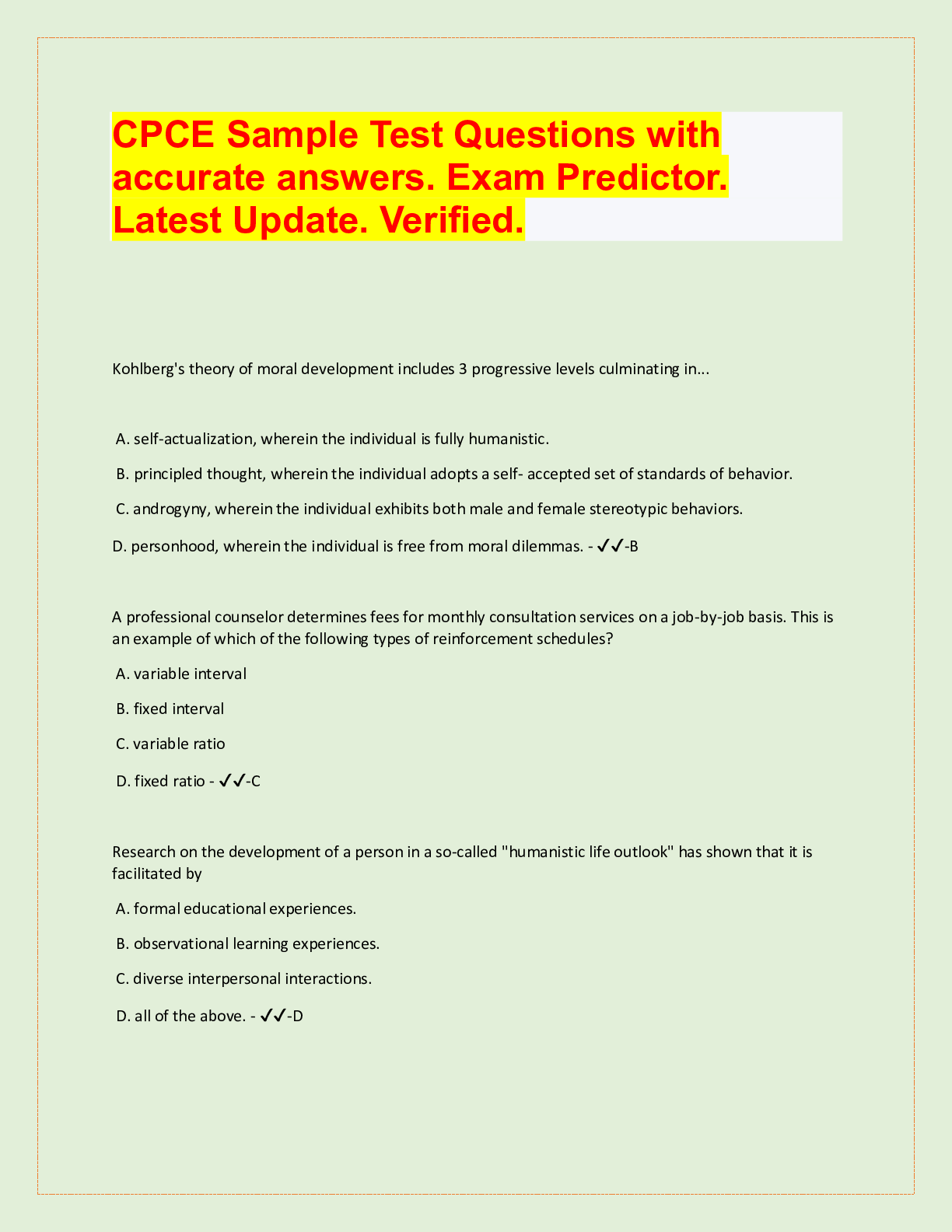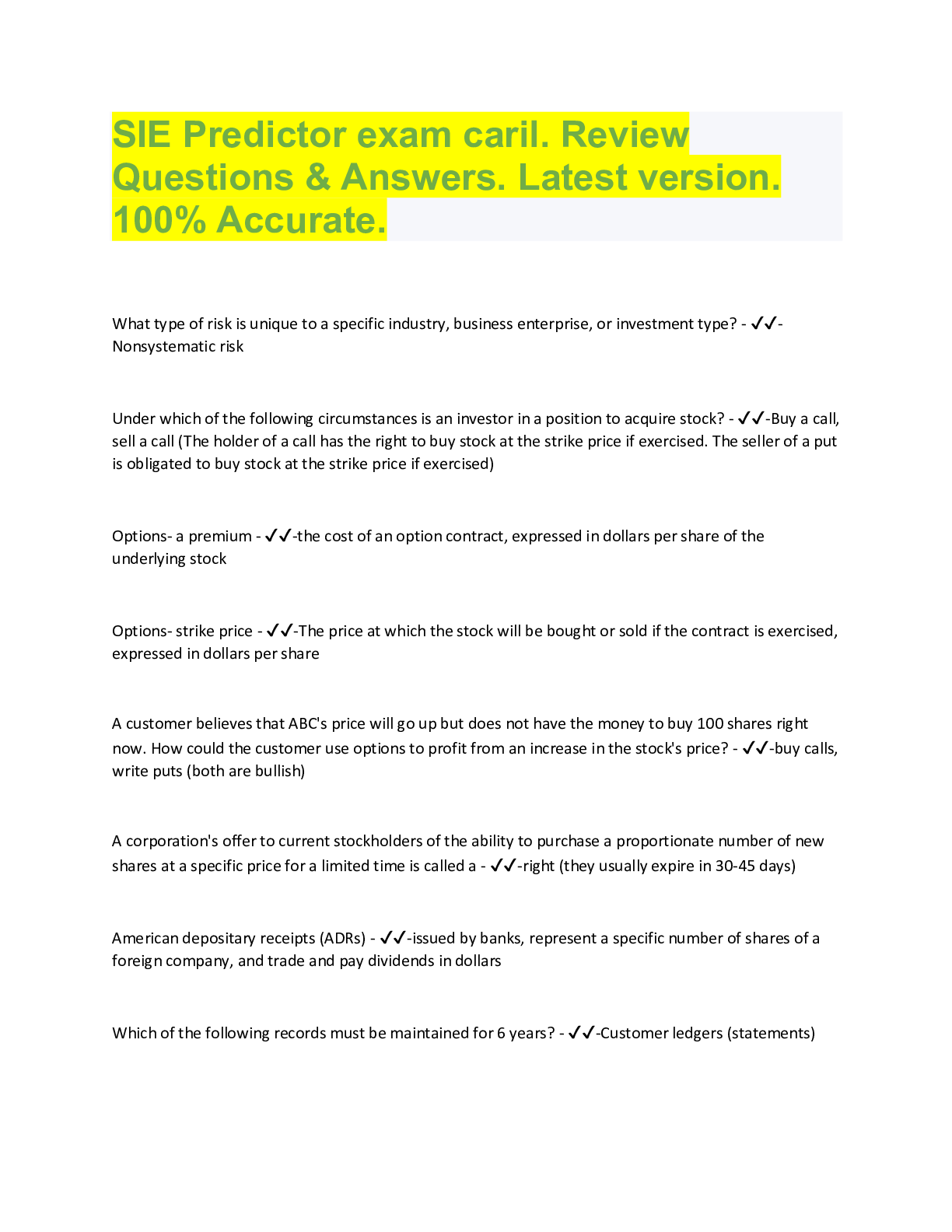Counseling > QUESTIONS & ANSWERS > NCMHCE Test Bank. All Sections coverage, questions & Answers. Latest update. Verified. (All)
NCMHCE Test Bank. All Sections coverage, questions & Answers. Latest update. Verified.
Document Content and Description Below
NCMHCE Test Bank. All Sections coverage, questions & Answers. Latest update. Verified. psychosis - ✔✔-one or more symptoms such as: hallucinations, delusions, disorganized thinking (evaluat... ed by speech), disorganized or abnormal motor behavior, negative symptoms *positive symptoms - ✔✔-* something added; i.e. hallucinations, delusions, disorganized thinking or motor behavior * negative symptoms - ✔✔-* something taken away; i.e. avolition, alogia, diminished emotional expression, asociality, anhedonia avolition alogia - ✔✔-2 most common symptoms in schizo individuals: 1. 2. alogia - ✔✔-decreased speech avolition - ✔✔-decreased motivation - presence of positive and negative symptoms - presence/absence of mood episodes - length of time - ✔✔-list 3 key points to look for in differential dx of schizophrenia spectrum * 6 months 1-6 months less than 1 month greater than one month - ✔✔-* duration of schizophrenia spectrum: schizophrenia: __________________ schizophreniform: _____________________ brief psychotic: ___________________ delusional disorder: ___________________ hallucinations - ✔✔-sensory perception that seems real but occurs without external stimulation; fully conscious (not falling asleep/waking up) i.e. visual, auditory, tactile, somatic, olfactory, gustatory delusions - ✔✔-fixed beliefs, unchanging in light of conflicting evidence; person cannot be convinced otherwise * bizarre delusion - ✔✔-* a delusion that involves a phenomenon that the person's culture would regard as physically impossible * erotomanic delusion - ✔✔-* a delusion that another person, usually of higher status, is in love with the individual * grandiose delusion - ✔✔-* a delusion of inflated worth, power, knowledge, identity, or special relationship to a deity or famous person * control delusion - ✔✔-* a delusion in which feelings, impulses, thoughts, or actions are experienced as being under the control of some external force rather than being under one's own control * referential delusion - ✔✔-* a delusion in which events, objects, or other ppl in on'e immediate environment are seen as having a particular and unusual significance; these delusions are usually of a negative or pejorative nature but also may be grandiose in content; this differs from when the false belief is not as firmly held nor as fully organized into a true belief * persecutory delusion - ✔✔-* a delusion in which the central theme is that one or someone to whom one is close is being attacked, harassed, cheated, persecuted, or conspired against * somatic delusion - ✔✔-* a delusion whose main content pertains to the appearance or functioning of one's body * thought broadcasting (delusion) - ✔✔-* a delusion that one's thoughts are being broadcast out loud so that they can be perceived by others * thought insertion (delusion) - ✔✔-* a delusion that certain of one's thoughts are not one's own, but rather are inserted into one's mind disorganized behavior - ✔✔-catatonic or disorganized motor behavior; - motor immobility (stupor or waxy flexibility) - excessive motor activity (silliness/agitation) - rigid, inappropriate, or bizarre posture - complete lack of verbal response (mutism) disorganized thinking - ✔✔-evaluated by speech - rapidly switching topics/derailment - answers are unrelated to questions/tangential - speech incoherence/word salad must be substantial enough to impair communication derailment - ✔✔-rapidly switching topics tangential - ✔✔-answers unrelated to questions word salad - ✔✔-speech incoherence alogia - ✔✔-impoverishment of thinking; evidenced by speech patterns - poverty of speech - poverty of content avolition - ✔✔-inability to initiate and persist in goal-directed activities of daily living (ADLs) asociality - ✔✔-lack of interest in social interactions anhedonia - ✔✔-decreased pleasure from positive stimuli affective disturbance - ✔✔-restriction in emotional expression alogia avolition asociality anhedonia affective disturbance - ✔✔-name 5 negative symptoms associated with the schizophrenia spectrum and a poorer prognosis when present: delusional disorder - ✔✔-- delusions lasting at least one month, with otherwise good functioning; - criterion A for schizophrenia never met; functioning/behavior not markedly impaired, odd, or bizarre; - if any mood episodes--> they are brief; not due to a medical condition or substance - hard to differentiate from good functioning schizophrenia, paranoid personality disorder specify: type, episode, and severity type episode severity - ✔✔-what 3 things do you need to specify for delusional disorder? brief psychotic disorder - ✔✔-1 or more sx of delusions, hallucinations, disorganized speech, or disorganized behavior - lasts 1 day to 1 month with full recovery - rule out mood, schizoaffective, schizophrenia, substance/medical condition specify: when started, severity schizophreniform disorder - ✔✔-2 or more sx for at least a month: delusions, hallucinations, disorganized speech, disorganized behavior, negative symptoms - if it lasts at least 1 month but less than 6 months --> it's provisional if not yet to 6 mo - rule out schizoaffective, depressive, bipolar disorders, substances/medical conditions specify prognosis and severity schizophrenia - ✔✔-multiple positive and negative sx, lasting at least 6 months with deterioration in functioning below baseline; 2 or more sx present for one month period: delusions, hallucinations, disorganized speech, disorganized behavior, negative sx; - rule out schizoaffective, depressive, bioplar - not due to substance/medical condition - caution with autism or communication disorder first episode, currently in acute episode first episode, currently in partial remission first episode, currently in full remission multiple episodes, currently in acute episode multiple episodes, currently in partial remission multiple episodes, currently in partial remission multiple episodes, currently in full remission continuous unspecified with catatonia severity - ✔✔-name 10 schizophrenia specifiers catatonic type disorganized type paranoid type undifferentiated type residual type - ✔✔-name 5 subtypes of schizophrenia taht were in DSM-III and IV but discontinued? schizoaffective disorder - ✔✔-mood and psychotic sx with a period of non-overlap; A. uninterrupted period of illness during which there is a mood episode concurrent with criterion A for schizophrenia; B. delusions or hallucinations present for 2+ weeks without mood sx C. mood sx present at least 1/2 total duration of illness D. not due to substance or medical condition inherently unreliable dx; specify mood type and severity catatonia* - ✔✔-* f3 or more of the following symptoms: stupor, catalepsy, waxy flexibility, mutism, negativism, posturing, mannerism, stereotypy, agitation, grimacing, echolalia, echopraxia reactive attachment disorder - ✔✔-evidence of pathogenic care; a consistent pattern of inhibited, emotionally withdrawn behavior toward adult caregivers (does not seek or respond to comfort); a persistent social and emotional disturbance characterized by at least 2: - minimal responsiveness - limited positive affect - episodes of unexplained irritability, sadness, or fearfulness - poor emotional regulation abilities pattern of extremes of insufficient care of client/child --> foster care and adoptions note age restrictions and specifiers disinhibited social engagement disorder - ✔✔-pattern of behavior involving culturally inappropriate, overly familiar behavior with relative strangers (i.e. crawling into a stranger's lap); behavior not limited to impulsivity; attention to age restrictions; etiology associated with social neglect; poor prognosis post traumatic stress disorder - ✔✔-triggered by exposure to actual or threatened death, serious injury, or sexual violation directly, witnessing, learning of close relation experience, or repeated exposure to aversive details; 4 distinct diagnostic clusters; sx for more than 1 month; specifiers: dissociative sx (depersonalization and derealization) and delayed expression (begins after 6 months) intrusion (criterion B) avoidance (criterion C) negative cognitions and mood (2X's/criterion D) arousal and reactivity (2X's/criterion E) - ✔✔-what are the 4 distinct diagnostic clusters of PTSD? play/reenactments cognitions - ✔✔-PTSD in young children may have symptoms appear in ________/__________________ and decreases reliance on self-reported _______________ acute stress disorder - ✔✔-primarily distinguished from PTSD by the time frame-- 3 days to 1 month of sxs and no specifiers; can be in children and adults; same sx clusters as PTSD but does not require criteria in each cluster: 9 or more form any of the 5 categories: intrusion negative mood dissociative sxs avoidance sxs arousal sxs intrusion negative mood dissociative sxs avoidance sxs arousal sxs - ✔✔-for acute stress disorder, CL needs to have 9 or more sxs from which 5 categories? adjustment disorders** - ✔✔-**sxs are in response to an identifiable stressor; response is "excessive"/marked distress and/or significant impairment; sxs develop within 3 months of onset and lasts no longer than 6 months after stressor/consequences have ceased; must include a specifier: w/ depressed mood, anxiety, mixed anxiety and depressed mood, disturbance of conduct, mixed disturbance of emotions and conduct, or unspecified - single event (termination of a romantic relationship) - multiple stressors (business difficulties/marital problems) - recurrent (seasonal stressors-- final exams) - continuous (painful illness with loss of ability, living in unsafe area) - impacted groups of people (natural disaster) - developmental (leaving home for college, becoming a parent) - ✔✔-list 5 stressors that can cause adjustment disorders * personality - ✔✔-* the system of individual psychological dispositions, the more or less permanent behavioral structure and operating mechanisms, distinctive for each human being, and reflective of the person's innermost tendencies at play in the interpersonal context * personality disorder - ✔✔-* an enduring pattern of inner experience and behavior that deviates markedly from the expectations of the individual's culture, is pervasive and inflexible, has an onset in adolescence or early adulthood, is stable over time, and leads to distress and impairment; associated w/ ways of thinking and feeling about oneself and others that significantly and adversely affect how an individual fxns in many aspects of life 1. conscientiousness 2. agreeableness 3. neuroticism 4. openness to experience 5. extraversion - ✔✔-5 factor model of personality?* conscientiousness - ✔✔-responsible and orderly agreeableness - ✔✔-cooperative and empathetic neuroticism - ✔✔-the tendency to experience negative emotions or easily upset openness to experience - ✔✔-being attentive to inner feelings and curiosity extraversion - ✔✔-being outgoing and energetic object relations personality sxs biological experiential - ✔✔-PERSPECTIVES ON FACTORS CONTRIBUTING TO PERSONALITY DISORDERS - child-rearing practices and poor attachment to caregivers results in poor ____________________ - __________________________ represent an unsuccessful attempt to resolve a crisis - ecosystemic perspectives - __________________ influences - _____________________: a person's unique interaction with his/her environment biological psychosocial - ✔✔-some personality disorders are thought to have more of a ______________________ basis (i.e. schizotypcal, paranoid, schizoid) -- such individuals may be more vulnerable to _______________________ stressors sexual dysfunction - ✔✔-disturbance in sexual desire or the psychophysiological changes that characterize the sexual response cycle paraphilic disorders - ✔✔-intense and persistent sexual interest other than sexual interest in genital stimulation or preparatory fondling with phenotypically normal, physically mature, consenting human partners gender dysphoria* - ✔✔-* distress that may accompany the incongruence b/w one's experience or expressed gender and one's assigned gender sexual dysfunctions - ✔✔-disturbance in sexual desire and in the psychophysiological changes that characterize the sexual response cycle * 1. desire 2. excitement 3. orgasm 4. resolution - ✔✔-* 4 phases of sexual response cycle? sexual dysfunctions interefer with 1 or more of these phases delayed ejaculation - ✔✔-can't ejaculate or takes a while to ejaculate 75% or more of the time erectile disorder - ✔✔-inability to maintain an erection 75% or more of the time female orgasmic disorder - ✔✔-inability to orgasm or to a lesser intensity 75% or more of the time; difficulty reaching female sexual interest/arousal disorder - ✔✔-decrease in female interest 75% or more of the time genito-pelvic pain/penetration disorder - ✔✔-tensing or tightening during sex, intense pain for women 75% or more of the time male hypoactive sexual desire disorder - ✔✔-decrease in male interest in sex 75% or more of the time premature ejaculation - ✔✔-early ejaculation within 1 minute of penetration substance/medication-induced sexual dysfunction - ✔✔-sexual dysfunction caused by intake of medication distress - ✔✔-sexual dysfunctions must cause clinically significant _________________ or impairment in functioning 1.8%, 33% 10%, 20% 20-30% 15% 10%, 25% - ✔✔-estimates for men and women: hypoactive disorder: _______% and _______% arousal: _______% and _______% premature ejaculation: _______% and _______% pain: ________% of females orgasm: _______% and _______% history physical examination behavioral anxiety cognitive couples homework - ✔✔-IMPLICATIONS OF SEXUAL DYSFUNCTIONS - thorough ____________ - referral for ______________________ - often primarily ________________ - psychoeducation - ______________ reduction - _______________ (self blame, expectations, fears) - _______________ work primarily (communication issues) - _______________ often critical paraphilic disorders - ✔✔-- a necessary but not sufficient condition for having this; by itself does not necessarily require clinical intervention; - MUST impair functioning or cause harm - 6 or more months required WHY INCLUDED? - 8 relatively common ones (more than 500 types) - some are seen as criminal offenses; voyeuristic d/o - ✔✔-observe a non-consenting person; peeping tom exhibitionistic d/o - ✔✔-exposing self to non-consenting person; frotteuristic d/o - ✔✔-touching or rubbing against a non-consenting person; genitals or non-genitcal contact sexual masochism d/o - ✔✔-self-suffering (beaten, humiliated, bound, etc); where they are in a position of not having power/taken away from them; when sig. clinical distress around it sexual sadism d/o - ✔✔-causing non-consenting suffering or fantasies distress; causes a clinical distress in life pedphilic d/o - ✔✔-fanaticizing distress or acting on a prepubescent child fetishistic d/o - ✔✔-nonliving object required for stimulation or nongenital body part (i.e. feet) to clinically sig. distress * abuse - ✔✔-* out of control situation; when one person determines what will happen; no consent is asked for or given; person being abused cannot stop what is happening; no concern is given to the needs, desires, and limits of the abused person; alcohol or drugs are often used before an episode of abuse; after an episode of abuse, the people involved feel bad transvestic d/o - ✔✔-arousal from cross-dressing causing clinically sig. distress; NOT a transgender person; doesn't have a gender identity different from the one given at birth other specified paraphilia - ✔✔-does not fit into any other category (i.e. animals/zoophilia, urine/urophilia, feces/coprophilia, corpses/necrophila) sexual dysfunction-- disorder incongruence "remission" "post transition" children incongruence - ✔✔-GENDER DYSPHORIA - removed from _______________________ in dsm 5; no longer a _________________ - new diagnostic class of gender ___________________; - "_________________" no longer used bc after treated --> it goes away; - "________________" specifier added - separate criteria for ______________ and adolescents/adults - a person with this feels there is an ___________________ b/w assigned gender and expressed gender gender dysphoria - ✔✔-- a person with this feels there is an incongruence b/w assigned gender and expressed gender - initial onset often b/w ages 2 and 4 in children - unique from sexual/affectational orientation; - very high rates of depression, suicide attempts (41%), substance abuse, hate crimes, etc. - insistence and persistence 41% - ✔✔-suicide attempt rate for transgender individuals? in particularly, it happens in adolescents with the onset of secondary sex characteristics gender dysphoria in adolescents and adults - ✔✔-a marked incongruence b/w one's experienced/expressed gender and assigned gender, of at least 6 months duration, as manifested by at least two of the following: - marked incongruence b/w one's experience/expressed gender and primary or secondary sex characteristics (in young adolescents, the anticipated sex characteristics) - a strong desire to be rid of one's primary and/or secondary sex characteristics bc of a marked incongruence w/ one's experienced/expressed gender (or in young adolescents, a desire to prevent the development of the anticipated secondary sex characteristics) - a strong desire for the primary and/or secondary sex characteristics of the other gender - strong desire to be of the other gender (or some alternative gender diff from one's assigned gender) - a strong desire to be treated as the other gender (or some alternative gender diff from one's assigned gender) - a strong conviction that one has the typical feelings and reactions of the other gender (or some alternative gender diff from one's assigned gender) ASSOCIATED WITH CLINICALLY SIG DISTRESS OR IMPAIRMENT IN SOCIAL, SCHOOL, OR OTHER IMPT AREAS 1. disorder of sex development (congenital adrenogenital disorder, congenital adrenal hyperplasia, or androgran insensitivity syndrome) 2. post-transition - ✔✔-specify which 2 things with gender dysphoria? post transition of gender dysphoria - ✔✔-when the individual has transitioned to full-time living in the desired gender (with or without legalization of gender change) and has undergone (or preparing to have) at least one cross-sex medical procedure or treatment regime-- namely, regularly cross-sex hormone treatment or gender reassignment surgery confirming the desired gender (i.e. penectomy, vaginoplasty in a natal male; mastectomy or phalloplasty in a natal female) 90% 10% - ✔✔-of eating and elimination disorders, _____% are female and ______% are male, but this is changing 0.4%-- .8% 1-1.5%-- 2.6% 0.8-1.6%-- 3.0% - ✔✔-DSM says eating disorders are rather rare: _____% of females have anorexia AND MORE RECENTLY ______% _____% of females have bulimia AND MORE RECENTLY ______% _____% of adults have binge eating disorder AND MORE RECENTLY ______% 40-50% - ✔✔-__________% of elementary age girls (6-12) think they are fat pica for children and pica for adults - ✔✔-- persistent eating of nonnutritive, nonfood substances (i.e. dirt, rocks, toilet paper, chalk); - inappropriate to developmental level - not culturally supported or socially normative - if another mental disorder is present, severe enough for additional clinical attention - for a sustained period of time - we don't know why - don't dx under 2 years of age rumination disorder - ✔✔-- repeated regurgitation of food (1 or more months) - babies or intellectual disabilities - children across age ranges - even healthy adolescents - not attributed to GI or other medical condition - not exclusively during another eating disorder - if during another medical disorder, severe enough for additional clinical attention TYPICAL ONSET: 3-12 months of age avoidant/restrictive food intake disorder - ✔✔-- persistent failure to meet appropriate nutritional and/or energy needs associated with: -- sig weight loss, failure to gain, faltering growth -- sig nutritional deficiency -- dependence on enteral feeding or oral supplements -- marked interference w/ psychosocial functioning - not due to lack of food or culture - not during another eating disorder or medical condition or mental disorder NOTE: individuals with this disorder do not express concern with weight or body shape; usually middle childhood anorexia** - ✔✔-a refusal to maintain a minimally normal body weight - by any means necessary -- vomit, restrict calories, exercise like crazy, etc. creating control bulimia** - ✔✔-repeated episodes of binge eating followed by inappropriate compensatory behaviors... - might have concerns about body weight too and restrict food (anorexic characteristic too) - losing control and making up for it anorexia nervosa - ✔✔-- restriction of energy intake leading to sig low weight - intense fear or gaining weight or becoming fat, or behavior that interferes with gain - disturbance in how experiences weight or shape, influence on self-evaluation, does not recognize serious - average onset: 19 - highest mortality rate of all psychiatric disorders: 4% SPECIFY: restricting type, remission status, BMI 19 - ✔✔-average onset of anorexia nervosa? anorexia nervosa - ✔✔-which disorder has the highest mortality rate of all psychiatric disorders at 4% bulimia nervosa - ✔✔-- recurrent episodes of binge eating -- discrete period of time eat much larger amount than normal AND -- sense of lack of control over eating during the episode - recurrent inappriopriate compensatory behavior to prevent weight gain - average once a week for 3 months - self-evaluation unduly influenced by body weight and shape - does not occur exclusively during anorexia - headaches, sore throat - might have certain triggers (stress) or habit SPECIFY: remission status, mild/moderate/severe/extreme 1-3X 4-7 8-13 14+ PER WEEK - ✔✔-For bulimia and binge eating disorders, what is considered: mild? moderate? severe? extreme? binge eating disorder - ✔✔-- recurrent episodes of binge eating -- discrete period of time eat much larger amount than normal AND -- sense of lack of control over eating during the episode - episodes associated w/ 3 or more rapidly, uncomfortably full, eating when not hungry, eatng alone due to embarrassment, feeling disgust/guilty - marked distress - average once a week for three months - not associated w/ compensatory behavior or during another ED SPECIFY: remission status, severity enuresis** - ✔✔-** repeated urine into bed or clothes, involuntary or intentional 2X a week for 3 months or CSDI - at least 5 years or equivalent developmental level - not attributable to substance or another medical condition - a lot of shame, anxiety over conflict in the family SPECIFY: nocturnal/diurnal/combo of both encopresis - ✔✔-- repeated passage of feces into inappropriate places, involuntary or intentional - at least once a month for 3 months - at least 4 years of age or equivalent development - not attributable to substance or another medical condition except through constipation specify: with/without constipation and overflow incontinence (involuntary, OR without constipation and overflow incontinence (incontinence not present)) oppositional defiant disorder - ✔✔-frequent and persistent pattern of angry/irritable mood, argumentative/defiant behavior, or vindictiveness - might be the start of conduct disorders --> attention-deficit or others; four or more for at least 6 MONTHS - must consider environment and development: - under age 5- most days for 6 or more months - 5+: at least once per week for at least 6 months must have clinically sig impairment or distress for CL or family or class - not exclusively duringpsychotic, substance use, depressive, or bipolar disorder; no disruptive mood dysregulation disorder angry argumentative/defiant vindictive - ✔✔-what are the 3 core sx of oppositional defiant disorder? ANGRY - loses temper - touchy/easily annoyed - angry/resentful ARGUMENTATIVE DEFIANT - argues w/ authority figures - defies or refuses to comply w/ authority figures/rules - deliberately annoys others - blames others VINDICTIVE - spiteful or vindictive at least twice in past 6 months - ✔✔-must meet 4 of which criteria for ODD? intermittent explosive disorder - ✔✔-adults have temper tantrums that are clinically sig; - recurrent outbursts representing faillure to control aggressive impulses -- verbal aggression or physical... 2X/week for 3 months without injury or damage -- 3 behavioral outbursts involving damage or injury within 12 months - mag out of proportion - not premeditated or or tangible objective - distress, impairment, financial, or legal consequences - at least 6 years of age/developmental level - not b/w explained by mental or medical condition; adjustment disorder consideration for children -- can be diagnosed alongside ADHD, CD, ODD, autism spectrum conduct disorder - ✔✔-a repetitive and persistent pattern of behavior in which the basic rights of others or major age-appropriate societal norms or rules are violated -- frequently encountered in among youth -- boys have higher rates than girls -- sx vary according to age and gender 3 or more sx in 12 months; at least one sx in last 6 months - repeititve and persistent pattern - clincally sig impairment - SPECIFY: onset, prosocial emotions, severity - bullies - fights - weapon - people - animals - stealing - sexual - fire - deliberate - broken - confrontation - 13 - twice - 13 - ✔✔-3+ sx in 12 months; at least 1 in last 6 months for conduct disorder - _____________/threat/intimidates - initiates physical ___________ - used a _____________ that could cause harm - physically cruel to _____________ - physically cruel to _____________ - _______________ while confronting victim - forced ______________ activity - deliberate ___________ setting - _______________ destruction of property - ______________ into houses/building/car - lies/cons - stolen items of nontrivial value without ____________________ - out all night before _____ - run away overnight at least __________; or once length - truant from school before 1____ 47-70% 84-96% - ✔✔-______% of children w/ CD are also dx w/ by ADHD ______% of children with CD also met criteria for ODD pyromania - ✔✔-deliberate and purposeful fire setting (more than once) - tension or affective arousal before - fascination, interest, curiosity, attention to fire - firesetting not pragmatic or due to another mental disorder - not conduct disorder, mania, or antisocial kleptomania - ✔✔-stealing things; recurrent failure to resist impulses to steal objects not needed for personal use or monetary value; tension or affective arousal before; pleasure, gratification, or relief when committing; not to express anger, vengeance, or response to psychosis; not conduct disorder, mania, or antisocial ODD CD APD - ✔✔-- untreated ADHD --> 80% dx of ______ by 12 - untreated ODD --> 50% dx of _____ by 16 - untreated CD --> majority ________ dx - child-rearing practices/poor attachment - unsuccessful attempt to resolve a crisis - ecosystemic perspectives - biological influences - experiential - ✔✔-5 perspectives that contribute to personality disorders? 2 different - ✔✔-DX criteria for PD's are poorly differentiated and overlap --> some individuals may have characteristics of _____________________ personality disorders depression anxiety - ✔✔-PDs are affected by which two disorders specifically? paranoid personality disorder - ✔✔-pervasive distrust and suspiciousness such that others' motives are interpreted as malevolent; FOUR OR MORE: - suspects others are harming him/her - questions loyalty/trustworthiness of friends and loved ones; reluctance to confide in others for fear of how that info may be used against him/her; - reads hidden demeaning or threatening meanings into benign remarks or events; looks for hidden meanings that might indicate that others intend to harm him/her; - bears grudges - perceives attacks on character/reputation that others do not see; - very jealous/doubts without justification fidelity of partners do not dx if sxs occur exclusively during the course of schizophrenia, mood disorder w/ psychotic features, another psychotic disorder, or due to physiological effects of GMC; typically seen in males, few close relationships; need to be independent and self-sufficient - enduring pattern of experience/behavior - pattern is inflexible and pervasive across situations - clinically sig distress/impairment - stable and long duration - not better accounted for by another mental disorder or substance - ✔✔-what are 5 general diagnostic criteria for personality disorders? [Show More]
Last updated: 2 years ago
Preview 1 out of 292 pages

Buy this document to get the full access instantly
Instant Download Access after purchase
Buy NowInstant download
We Accept:

Also available in bundle (1)

NCMHCE Assessments BUNDLE, VERIFIED EXAM PAPERS
NCMHCE Assessments Top Exam Questions and answers. 100% Accurate. verified. 17 VERSIONS 2023/2024
By Topmark 2 years ago
$45
16
Reviews( 0 )
$15.00
Can't find what you want? Try our AI powered Search
Document information
Connected school, study & course
About the document
Uploaded On
Mar 12, 2023
Number of pages
292
Written in
Additional information
This document has been written for:
Uploaded
Mar 12, 2023
Downloads
0
Views
116

